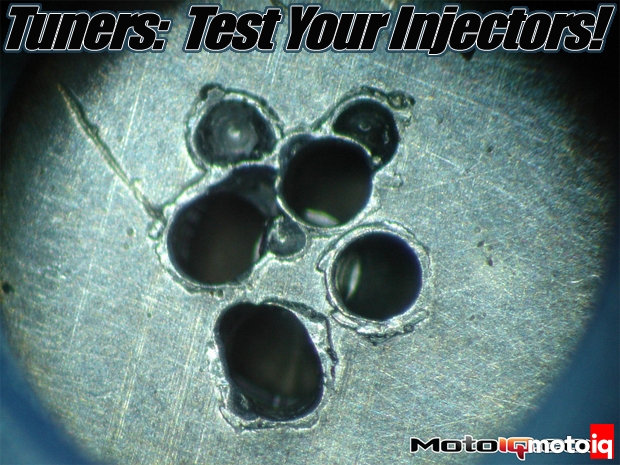,
This leaves the lowly Mineral Spirits as a practical contender for day-to-day testing. The up side is it’s easily obtained locally and it’s less likely to turn your shop into an inferno. The down side is the viscosity is about twice that of the other fluids including gasoline. The specific gravity of Mineral Spirits is also heavier than the other fluids with gasoline about .640, N-Heptane at .683, 40CFR86 at .740, and Mineral Spirits the heavy weight at .780. In the real world of comparative testing, this is easily corrected for by controlling fluid temperatures and using corrective coeffecients on the test results.



Above, are examples of injectors that were purchased from companies that specialize in drilling out stock injectors. Damaged pintle heads, drill burrs in holes not removed; holes which are poorly finished and inconsistent. Flow values off by more than 10% from advertised values and variances as high as 50cc/min within a set are not rare.
There will be a slight non-linearity between Mineral Spirits and N-Heptane due to the viscosity difference when comparing flow rates between a single orifice and a multi-orifice injector of the same flow rate. This is due to the additional surface friction of multiple orifices vs. a single orifice of the same total cross sectional area. This isn’t a normal test scenario, but would be a good reason to break out the N-Heptane. Testing static and dynamic flows with both fluids on both types of injectors will give you a good calibration factor for Mineral Spirits vs. N-Heptane.



Damage to the pintle head from using it as a drill stop, causes a significant amount of turbulence at the hole entrances, making repeatable flow tests impossible. Use drilled injectors, in expensive performance engines at your own risk.
On the hardware side, you will need a good adjustable 20+ amp. 0-20V power supply to run the pump and injectors, an accurate adjustable timer, an adjustable square wave signal generator with a driver to control the injector, a 2 channel oscilloscope, a DC Inductive Current Probe, and an Accelerometer or you can substitute a Bosch detonation sensor (the type with a hole in the center) to measure closing latency. Construct a fluid reservoir with a pump, filter and regulator (with a lab quality pressure/temperature gauge or sensor as close to the injector as possible). See section 6 of J1832 for a full test rig description. The preference is to measure flow quantities by weight more so than by volume, so basically you will be starting with a good .1 gram accuracy scale (with a serial port if you want to automate the rig later) with a bucket on it.
 |
| This multi hole injector is a mess. Any flow vectoring is gone and the holes are full of burrs. The pintel head is probably dinged as well. Put this in your engine? It’s cheap! |
Basically, you will setup the test stand to flow an injector into the bucket on the scale. Acoustically attach (IE. metal to metal) the Bosch Detonation Sensor to the clamp holding the injector above the bucket and connect it to channel #2 of your scope, channel #1 of the scope is connected to the Inductive Current Probe, which is clamped onto the signal wire firing the injector. Setup the power supply with a switch for the pump, one for power to the injector thru the timer for static flow tests and one thru the timer and then thru the Signal Generator / Driver for dynamic flow testing (a pulse counter is also a nice addition to confirm the pulse count). Ok, that said, again, J1832 contains the specifications for accuracy and resolution required for the above mentioned components, so read it before buying anything you don’t already have.
 |
| The holes are burred and hacked. The damage to the pintle head is very obvious when looking through the holes. This is a very well known brand of modded injectors, popular in the Nissan and EVO tuning world. |
The following is a basic description of the setup and operation of a test rig, plus a few details not in J1832 (yet ;-). Setup the scope to trigger on the Current Probe on channel #1 and set the display for 1ms per division, the amplitude setting isn’t important, just set it so you can see both channels. Once you have the scope triggering on channel #1, the Det. Sensor on channel #2 will show the injector pintle hitting the full open stop inside the injector on opening and hitting the seat on closing. When setup correctly, channel #2 will show a ringing oscillation when the injector pintle hits full open, with the first upward oscillation of the ringing pattern coinciding with a “knee” in the Current wave form on channel #1.
 |
| The holes are all different sizes and every single one has smacked the pintle head. All of these pictures were taken with a microscope which should give you a clue as to how small these holes are. You cannot drill stuff like this under aftermarket like conditions. Machining these holes requires special processes that OEM’s have access to. |
The “knee” is a slight deviation in the rising current caused when the pintle movement thru the magnetic field stops. Use these two coinciding events on both channels to confirm everything is correctly displayed, since on the closing side, the fully closed event does not have a coinciding event on channel #1 for confirmation. On the closing side, channel #1 will be a fairly straight vertical dropping line as power is turned off and channel #2 will show another ringing oscillation, typically .5ms to 1ms after power is turned off. The first downward cycle of the oscillation is the pintle hitting the seat, indicating the injector has fully closed.



